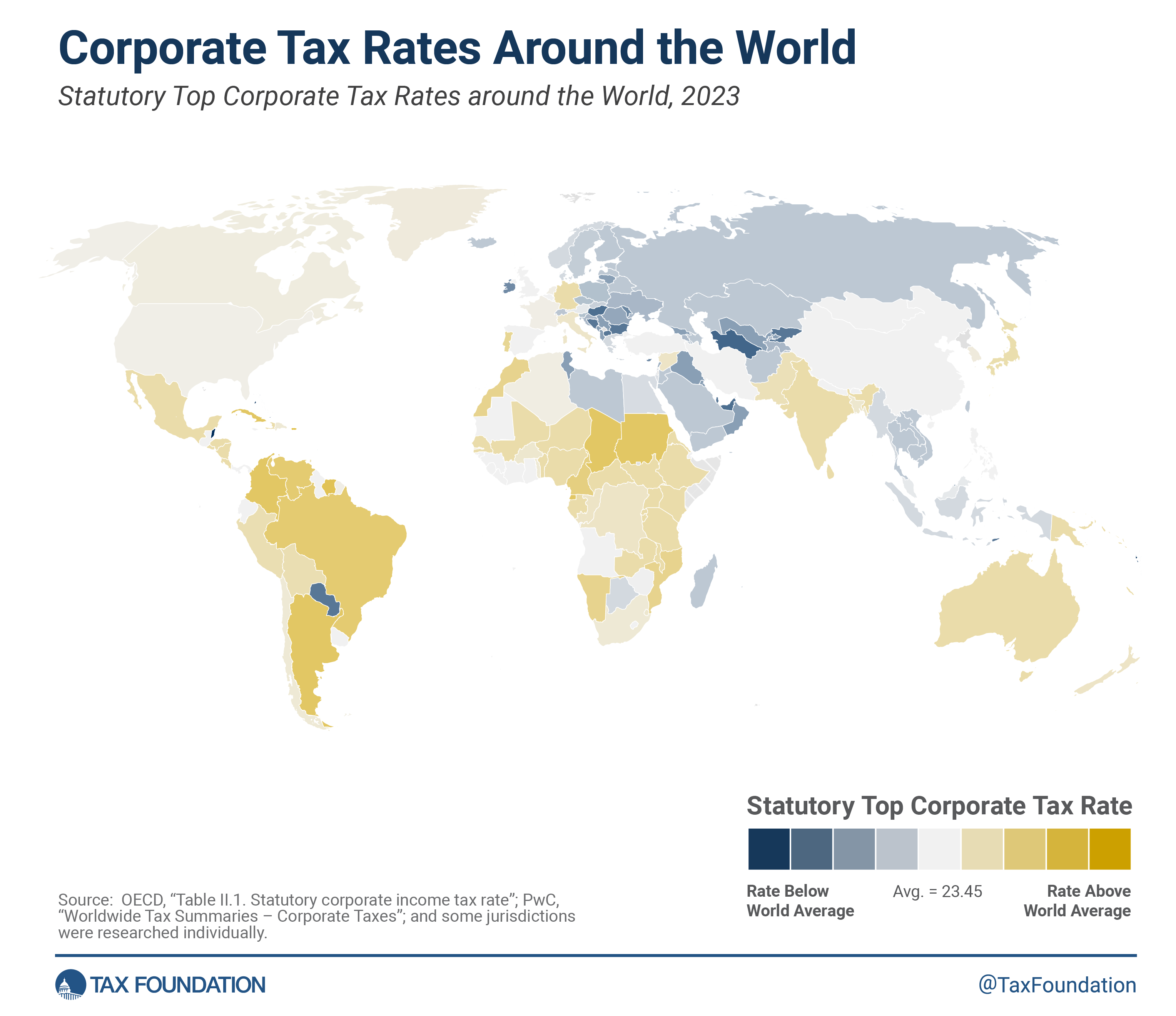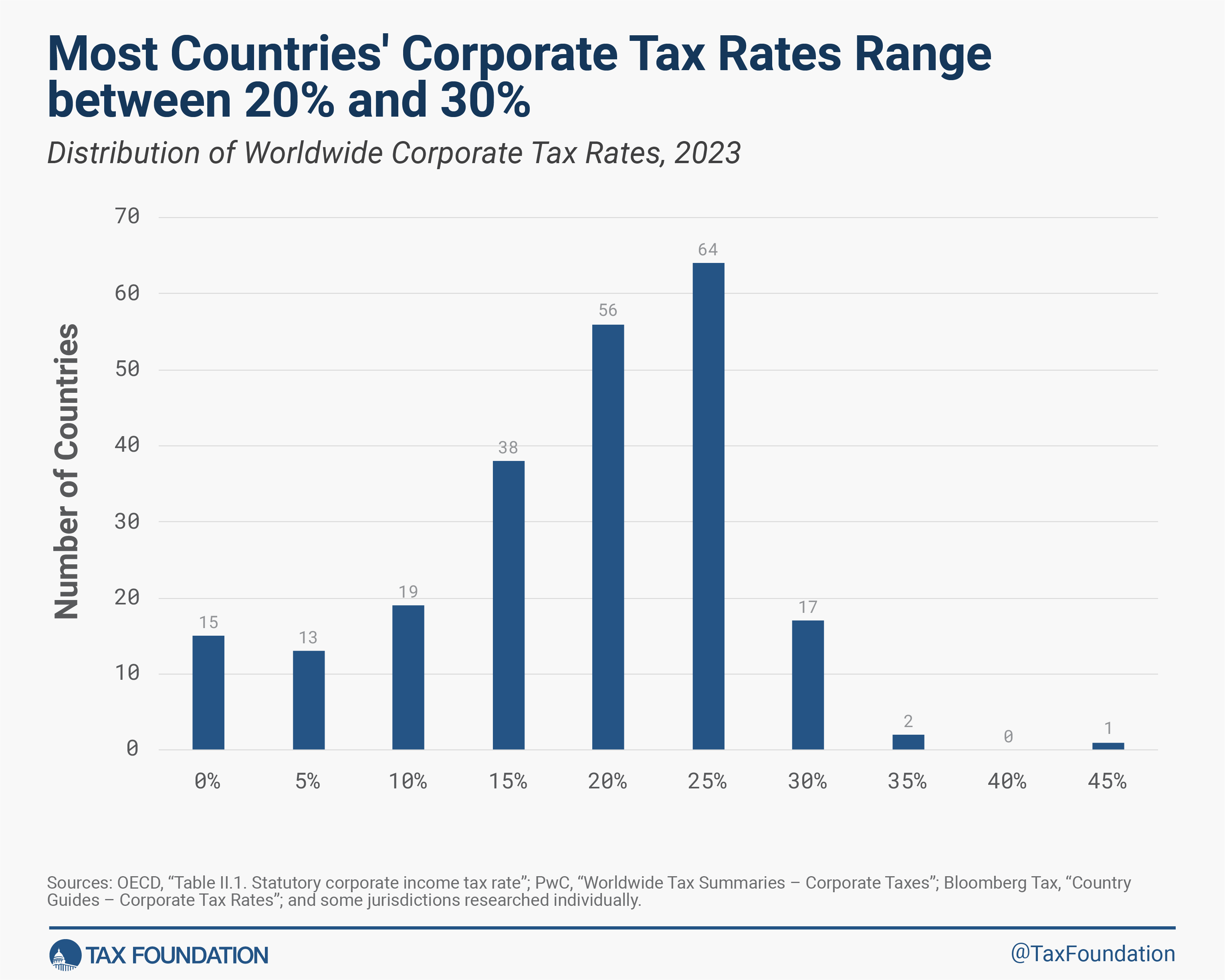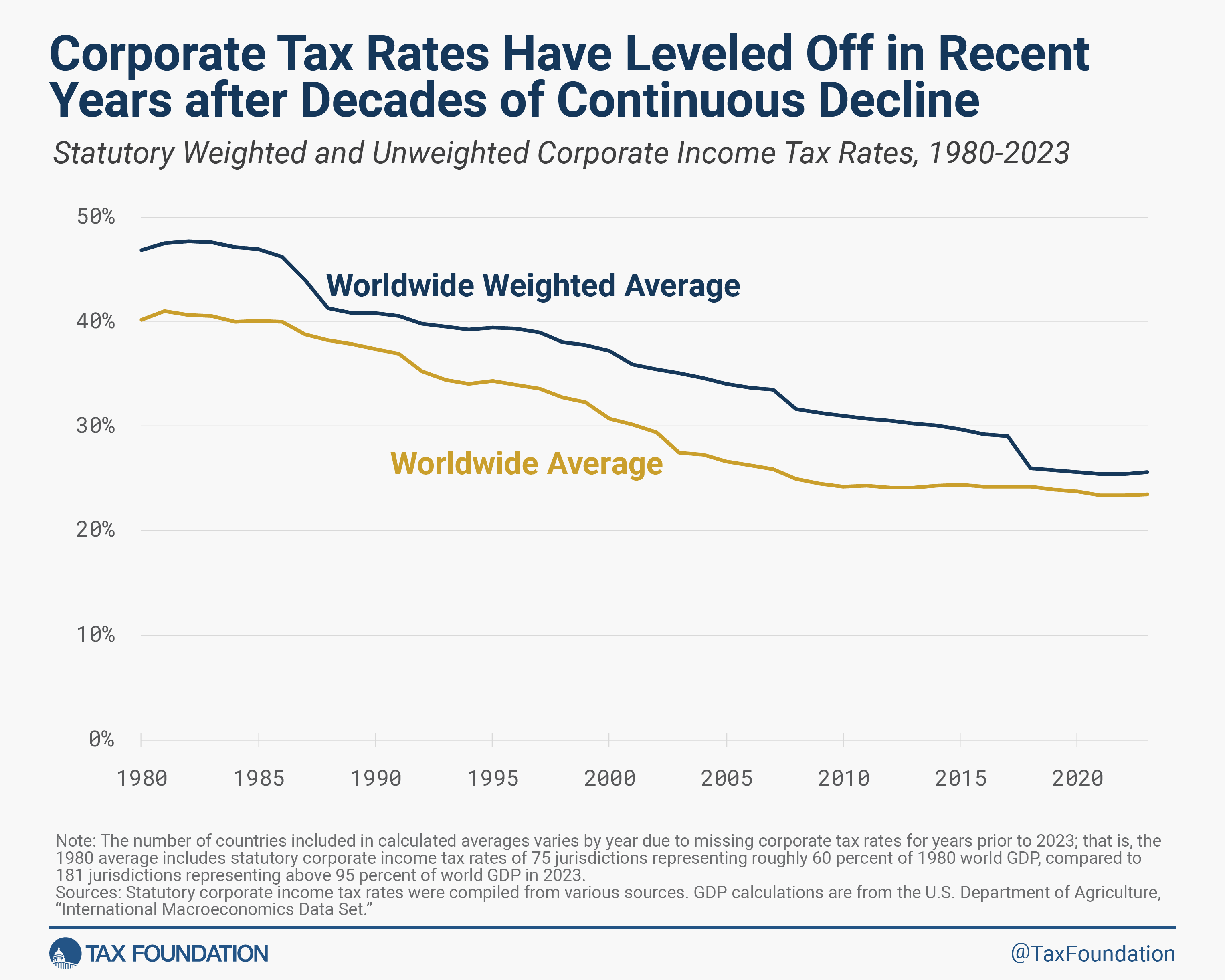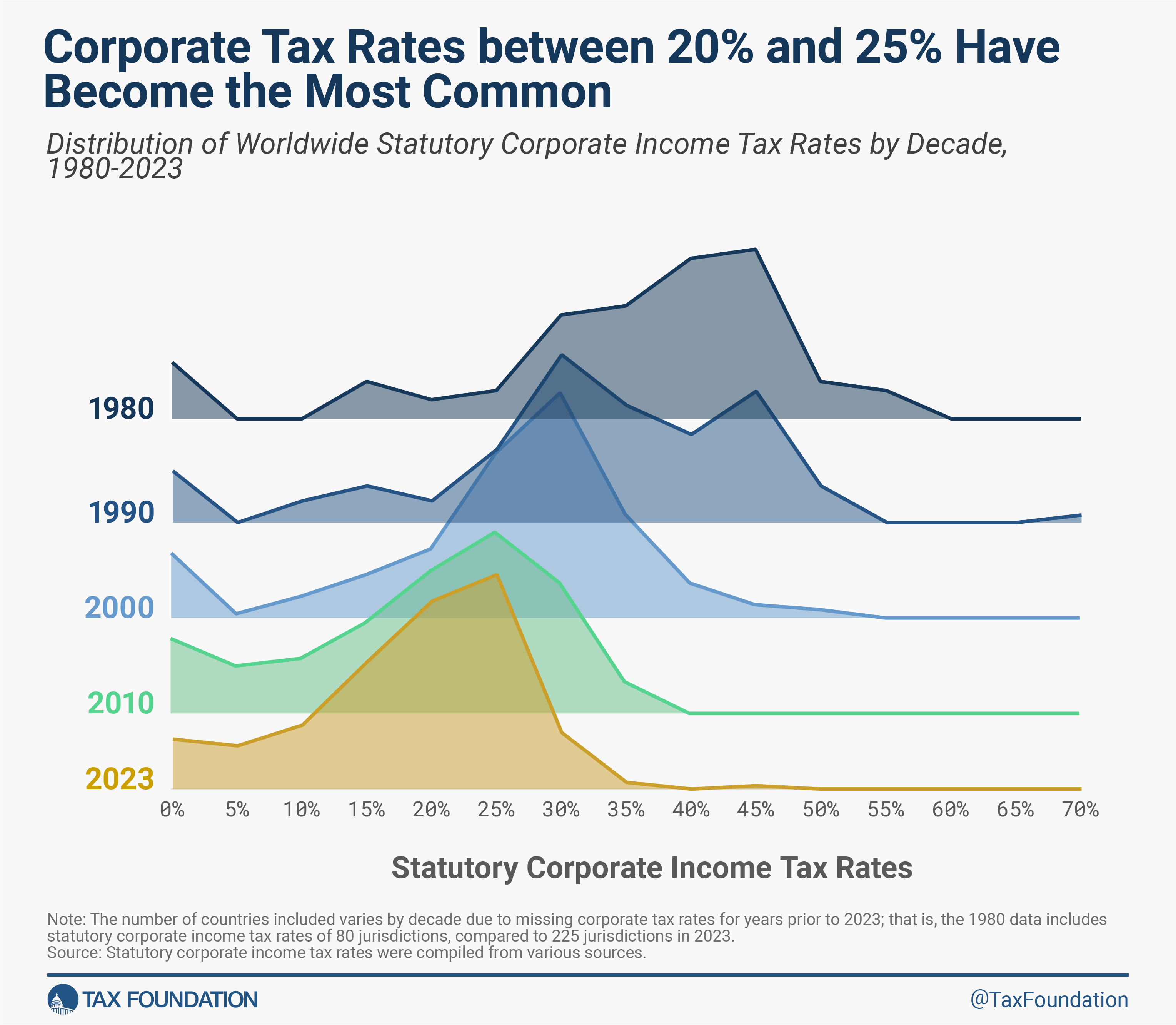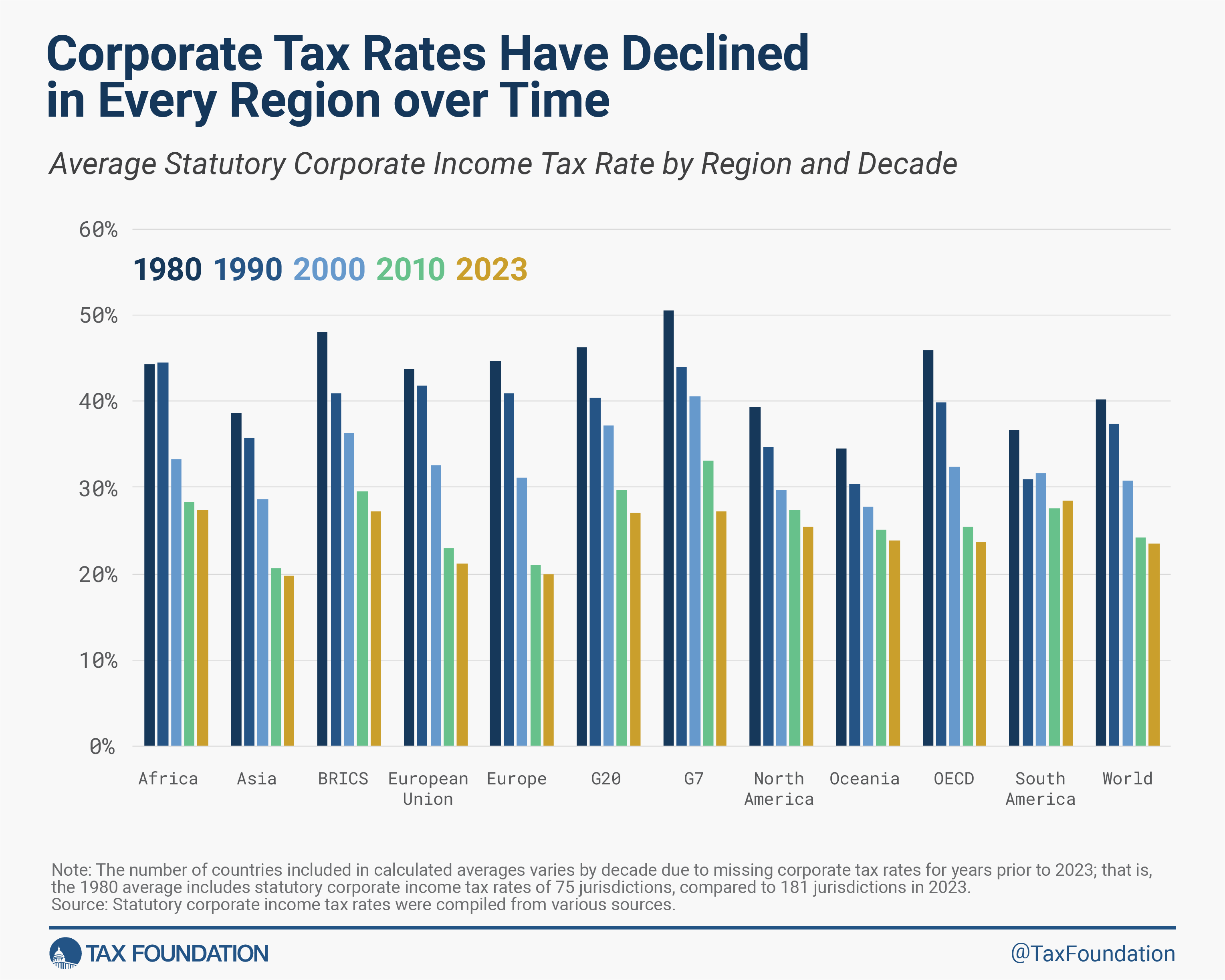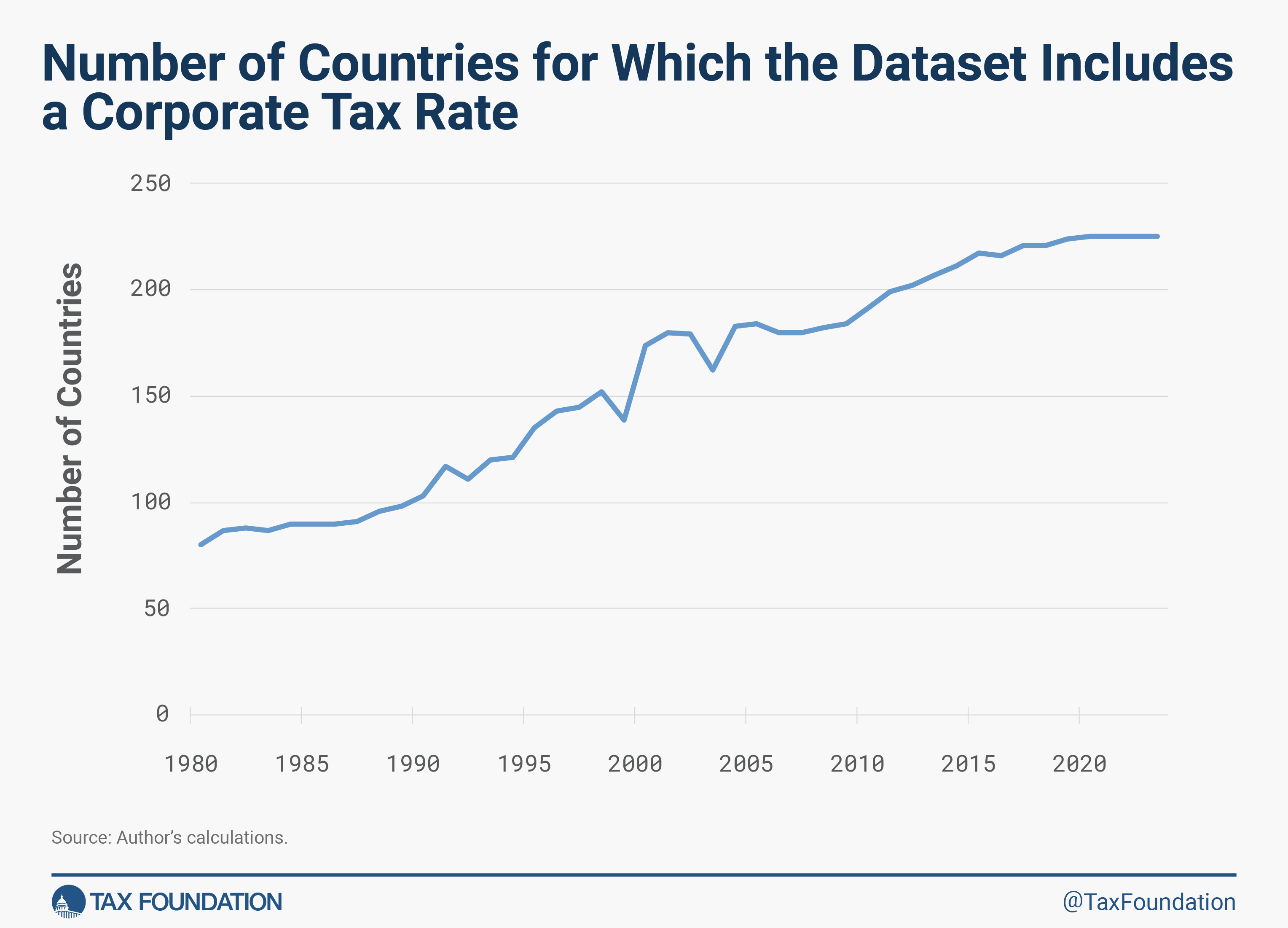Corporate Tax Rates around the World, 2023
Key Findings
- In 2023, 13 countries made changes to their statutory corporate income taxA corporate income tax (CIT) is levied by federal and state governments on business profits. Many companies are not subject to the CIT because they are taxed as pass-through businesses, with income reportable under the individual income tax.
rates. Six countries—Belarus, Morocco, Sri Lanka, Turkey, the United Arab Emirates, and the United Kingdom—increased their top corporate taxA tax is a mandatory payment or charge collected by local, state, and national governments from individuals or businesses to cover the costs of general government services, goods, and activities.
rates, while 7 countries—including Austria and Guinea—reduced their corporate tax rates. - The countries with the highest corporate tax rates in the world are Comoros (50 percent), Puerto Rico (37.5 percent), and Suriname (36 percent), while the countries with the lowest corporate rates are Barbados (5.5 percent), Turkmenistan (8 percent), and Hungary (9 percent). Fifteen jurisdictions do not impose a corporate tax.
- Some low-tax jurisdictions that previously did not have a corporate income tax have implemented or are exploring implementation options due to the Organisation for Co-operation and Development (OECD) Pillar Two agreement. These include the United Arab Emirates, Bermuda, Guernsey, Jersey, and the Isle of Man.
- The worldwide average statutory corporate income tax rate, measured across 181 jurisdictions, is 23.45 percent. When weighted by GDP, the average statutory rate is 25.67 percent.
- Asia has the lowest regional average rate at 19.80 percent, while South America has the highest regional average statutory rate at 28.38 percent. However, when weighted by GDP, Europe has the lowest regional average rate at 24.49 percent and South America has the highest at 32.65 percent.
- The average top corporate rate among EU Member States is 21.13 percent, 23.73 percent in OECD countries, and 27.18 percent in the
- The worldwide average statutory corporate tax rate has consistently decreased since 1980 but has leveled off in recent years.
- The average statutory corporate tax rate has declined in every region since 1980.
Introduction
In 1980, corporate tax rates around the world averaged 40.18 percent, and 46.83 percent when weighted by GDP.[1] Since then, countries have recognized the impact that high corporate tax rates have on business investment decisions; in 2023, the average is now 23.45 percent, and 25.67 when weighted by GDP, for 181 separate tax jurisdictions.[2]
Declines have been seen in every major region of the world, including in the largest economies. In the United States, the 2017 Tax Cuts and Jobs Act brought the country’s statutory corporate income tax rate from the fourth highest in the world closer to the middle of the distribution.[3]
Asian and European countries tend to have lower corporate income tax rates than countries in other regions, and many developing countries have corporate income tax rates that are above the worldwide average.
Today, most countries have corporate tax rates below 30 percent.
Notable Corporate Tax Rate Changes in 2023
Thirteen countries changed their statutory corporate income tax rates in 2023. Six countries increased their top corporate rates: Morocco (31 percent to 32 percent), United Arab Emirates (0 percent to 9 percent), Sri Lanka (24 percent to 30 percent), Turkey (23 percent to 25 percent), Belarus (18 percent to 20 percent) and the United Kingdom (19 percent to 25 percent). In 2023, the United Arab Emirates introduced a federal corporate tax of 9 percent on taxable incomeTaxable income is the amount of income subject to tax, after deductions and exemptions. For both individuals and corporations, taxable income differs from—and is less than—gross income.
above AED 375,000 (USD 102,000). However, the new corporate income tax will not apply to the extraction of natural resources as these activities are already subject to taxation in the Emirates.[4]
Seven countries across four continents—Guinea, South Africa, Bangladesh, the Republic of Korea, Austria, Aruba, and Saint Vincent and the Grenadines—reduced their corporate tax rates in 2023. The tax rate reductions ranged from just 1 percentage point in Austria, the Republic of Korea, and South Africa, to 10 percentage points in Guinea.
Scheduled Corporate Tax Rate Changes in the OECD and Selected Jurisdictions
Among OECD countries, Austria and Morocco have announced they will implement changes to their statutory corporate income tax rate over the coming years.
- In Austria, the corporate income tax will be cut from 24 percent in 2023 to 23 percent in 2024.[5]
- In Morocco, the top corporate income tax was increased from 31 percent to 35 percent for companies with a taxable income higher than MAD 100 million (USD 9.9 million). However, this increase will be introduced over three years, with a one percentage point increase each For the fiscal year of 2023, the corporate income tax rate applicable is 32 percent. [6]
The Impact of Global Minimum Tax
More than 140 countries have already agreed to a 15 percent global minimum tax, as part of the 2021 global tax agreement coordinated by the OECD. The model rules defined by the OECD under the global minimum tax, also known as Pillar Two, are incentivizing countries around the world to implement a corporate income tax for the first time.
Apart from the United Arab Emirates, which has recently introduced a 9 percent federal corporate income tax, Bermuda is also considering introducing a corporate income tax for the first time.
In recent years, the Bermuda government extended the tax exemptionA tax exemption excludes certain income, revenue, or even taxpayers from tax altogether. For example, nonprofits that fulfill certain requirements are granted tax-exempt status by the IRS, preventing them from having to pay income tax.
granted to Bermuda companies until March 2035. This exemption is supposed to protect companies from any newly enacted taxes on income or capital gains until March 2035.[7] However, in October 2023, to “minimize top-up taxes” levied on Bermuda multinational companies, draft legislation was presented to adopt a 15 percent statutory corporate income tax.[8]
Additionally, in May 2023, the governments of Guernsey, Jersey, and the Isle of Man agreed on a joint internal approach to Pillar Two starting in 2025.[9]
At the end of 2022, the EU also adopted its own Pillar Two directive and all Member States have committed to implement the EU rules. The Member States are obliged to implement the rules by 31 December 2023.[10] While some Member States required to implement the directive are not expected to meet the end of 2023 deadline, Estonia, Latvia, Lithuania, Malta, and the Slovak Republic already announced that they intend to defer the application to a later date as this is allowed by the directive under certain conditions.
However, while countries are looking for ways to implement the global minimum tax rate, they are also considering new qualified refundable tax creditA refundable tax credit can be used to generate a federal tax refund larger than the amount of tax paid throughout the year. In other words, a refundable tax credit creates the possibility of a negative federal tax liability. An example of a refundable tax credit is the Earned Income Tax Credit.
incentives for multinational companies allowed under the framework to continue competing for investment.[11]
The Highest and Lowest Corporate Tax Rates in the World
One hundred and forty-one of the 225 separate jurisdictions surveyed in 2023 have corporate tax rates at or below 25 percent.[12] One hundred and twenty have rates above 20 percent but below or at 30 percent. The average rate among the 225 jurisdictions is 22.27 percent.[13] The United States has the 84th-highest corporate tax rate with a combined federal and state statutory rate of 25.77 percent.[14]
The 20 countries with the highest statutory corporate income tax rates span almost every region, albeit unequally. While eight of the top 20 countries are in Africa, Oceania appears only once and Europe twice. Of the remaining jurisdictions, four are in North America, and five are in South America.
On the other end of the spectrum, the 20 countries with the lowest non-zero statutory corporate tax rates all charge rates at or below 15 percent. Nine countries have statutory rates of 10 percent, five being small European nations (Andorra, Bosnia and Herzegovina, Bulgaria, Kosovo, and Macedonia). The only two OECD members represented among the bottom 20 countries are Hungary and Ireland. Hungary reduced its corporate income tax rate from 19 to 9 percent in 2017. Ireland has had its 12.5 percent rate in place since 2003.
Of the 225 jurisdictions surveyed, 15 currently do not impose a general corporate income tax. All these jurisdictions are small, island nations. A handful, such as the Cayman Islands and Bermuda, are well known for their lack of corporate taxes.
Regional Variation in Corporate Tax Rates
Corporate tax rates can vary significantly by region. South America has the highest average statutory corporate tax rate among all regions at 28.38 percent. Asia has the lowest average statutory corporate tax rate among all regions at 19.80 percent.
When weighted by GDP, South America has the highest average statutory corporate tax rate at 32.65 percent, while Europe has the lowest at 24.49 percent.
In general, larger and more industrialized nations tend to have higher corporate income tax rates than smaller nations. The G7, which is comprised of the seven wealthiest nations in the world, has an average statutory corporate income tax rate of 27.18 percent and a weighted average rate of 26.68 percent. OECD member states have an average statutory corporate tax rate of 23.73 percent and a rate of 26.16 percent when weighted by GDP. The BRICS[15] have an average statutory rate of 27.20 percent and a weighted average statutory corporate income tax rate of 26.11 percent.
The following map illustrates the current state of corporate tax rates around the world. Countries in Africa and South America tend to have higher corporate tax rates than Asian and European jurisdictions. Oceania’s and North America’s corporate tax rates tend to be close to the world average.
Distribution of Corporate Tax Rates
Only three tax jurisdictions impose a corporate income tax at statutory rates greater than 35 percent. [16] The following chart shows a distribution of corporate income tax rates among 225 jurisdictions in 2023. A plurality of countries (120 total) impose a rate above 20 percent and below or at 30 percent. Seventeen jurisdictions have a statutory corporate tax rate above 30 percent and below or at 35 percent. Eighty-five jurisdictions have a statutory corporate tax rate below or at 20 percent, and 205 jurisdictions have a corporate tax rate below or at 30 percent.
The Decline of Corporate Tax Rates since 1980 Leveled Off in Recent Years
Over the past 43 years, corporate tax rates have consistently declined on a global basis. In 1980, the unweighted average worldwide statutory tax rate was 40.18 percent. Today, the average statutory rate stands at 23.45 percent—a 42 percent reduction.[17]
Despite a general decline in corporate tax rates around the world, OECD and non-OECD countries have also become more reliant on revenue from corporate income taxes. One cause for this change has been a shift in the jurisdictions included.[18] Secondly, the negative revenue impact of the decline in corporate tax rates was generally offset by reducing or abolishing tax relief policies. [19]
The weighted average statutory rate has remained higher than the simple average over this period. Prior to U.S. tax reform in 2017, the United States was largely responsible for keeping the weighted average higher, given its relatively high tax rate, as well as its significant contribution to global GDP. Figure 3 shows the significant impact the change in the U.S. corporate rate had on the worldwide weighted average. The weighted average statutory corporate income tax rate has declined from 46.83 percent in 1980 to 25.67 percent in 2023, representing a 45 percent reduction over the 43 years surveyed.
Over time, more countries have shifted to taxing corporations at rates of 30 percent or lower, with the United States following this trend with its tax changes at the end of 2017. The largest shift occurred between 1990 and 2000, with 49 percent of countries imposing a statutory rate below 30 percent in 2000 and only 27 percent of countries in the dataset imposing a statutory rate below 30 percent in 1990. This trend continued between 2000 and 2010, with 79 percent of countries imposing a statutory rate below 30 percent in 2010. Currently, 91 percent of countries impose a statutory rate below 30 percent.[20]
All regions saw a net decline in average statutory rates between 1980 and 2023. The average declined the most in Europe, with the 1980 average of 44.6 percent dropping to 19.92 percent—a 55 percent decline. South America has seen the smallest decline, with the average only decreasing by 23 percent, from 36.66 percent in 1980 to 28.38 percent in 2023.
South America saw two periods, 1990-2000 and 2010-2023, during which the average statutory rate increased slightly by less than one percentage point, although the average rate decreased over the full 43-year period.
Conclusion
Worldwide and regional average top statutory corporate tax rates have declined over the past four decades due to countries turning to more efficient tax types.[21] However, they have leveled off in recent years. Of the 225 jurisdictions around the world, only six have increased their top corporate income tax rate in 2023, a trend that might be reversed in the coming years as more countries agree to implement the global minimum tax.
Compare Al 2023 Corporate Tax Rates
Stay informed on the tax policies impacting you.
Subscribe to get insights from our trusted experts delivered straight to your inbox.
Subscribe
Appendix
The Dataset
Scope
The dataset compiled for this publication includes the 2023 statutory corporate income tax rates of 225 sovereign states and dependent territories around the world. Tax rates were researched only for jurisdictions that are among the around 250 sovereign states and dependent territories that have been assigned a country code by the International Organization for Standardization (ISO). As a result, zones or territories that are independent taxing jurisdictions but do not have their own country code are generally not included in the dataset.
In addition, the dataset includes historic statutory corporate income tax rates from 1980 to 2022. However, these years cover tax rates of fewer than 225 jurisdictions due to missing data points. Please let Tax Foundation know if you are aware of any sources for historic corporate tax rates that are not mentioned in this report, as we constantly strive to improve our datasets.
To be able to calculate average statutory corporate income tax rates weighted by GDP, the dataset includes GDP data for 181 jurisdictions. When used to calculate average statutory corporate income tax rates, either weighted by GDP or unweighted, only these 181 jurisdictions are included (to ensure the comparability of the unweighted and weighted averages).
Definition of Selected Corporate Income Tax Rate
The dataset captures standard top statutory corporate income tax rates levied on domestic businesses. This means:
- The dataset does not reflect special tax regimes, including but not limited to patent boxes, offshore regimes, or special rates for specific industries.
- A number of countries levy lower rates for businesses below a certain revenue threshold. The dataset does not capture these lower rates.
- A few countries levy gross revenue taxes on businesses instead of corporate income taxes. Since the tax rates of a corporate income tax and a gross revenue tax are not comparable, these countries are excluded from the dataset.
- Some countries have a separate tax rate for nonresident companies. This dataset does not consider nonresident tax rates that differ from the general corporate rate.
Sources
Tax Rates for the Year 2023
For OECD and non-OECD countries, the statutory corporate income tax rates used are the combined corporate income tax rates provided by the OECD; see OECD, “Table II.1. Statutory corporate income tax rate,” updated April 2023, and “Statutory Corporate Income Tax Rates,” updated November 2023, Another source used for non-OECD jurisdictions is the statutory rates provided by PwC, “Worldwide Tax Summaries – Corporate Taxes,” 2023, The study also relies on Bloomberg Tax, “Country Guides – Corporate Tax Rates,” accessed in November 2023, Jurisdictions that are not part of these sources were researched individually. The source for each of these jurisdictions is listed in a GitHub repository; see Tax Foundation, “worldwide-corporate-tax-rates,” GitHub,
Tax Rates for the Years 1980-2022
Tax rates for the time frame between 1980 and 2022 are taken from a dataset compiled by the Tax Foundation over the last few years. These historic rates come from multiple sources: PwC, “Worldwide Tax Summaries – Corporate Taxes,” 2010-2022; KPMG, “Corporate Tax Rate Survey,” 1998- 2003; KPMG, “Corporate tax rates table,” 2003-2019; EY, “Worldwide Corporate Tax Guide,” 2004-2019; OECD, “Historical Table II.1 – Statutory corporate income tax rate,” 1999, the University of Michigan – Ross School of Business, “World Tax Database,” and numerous government websites.
Gross Domestic Product (GDP) for the years 1980-2023
GDP calculations are from the U.S. Department of Agriculture, “International Macroeconomics Data Set- Historical and projected real gross domestic product (GDP) and growth rates of GDP for baseline countries/regions (in billions of 2015 dollars) 1970-2033,” August 3, 2022,
References
[1] Unless otherwise noted, calculated averages of statutory corporate income tax rates only include jurisdictions for which GDP data is available for all years between 1980 and 2023. For 2023, the dataset includes statutory corporate income tax rates of 225 jurisdictions, but GDP data is available for only 181 of these jurisdictions, reducing the number of jurisdictions included in calculated averages to 181. For years prior to 2023, the number of countries included in calculated averages varies by year due to missing corporate tax rates; that is, the 1980 average includes statutory corporate income tax rates of 75 jurisdictions, compared to 181 jurisdictions in 2023.
[2] Statutory corporate income tax rates are from OECD, “Table II.1. Statutory corporate income tax rate,” updated April 2023, and “Statutory Corporate Income Tax Rates,” updated November 2023, PwC, “Worldwide Tax Summaries – Corporate Taxes,” 2023, Bloomberg Tax, “Country Guides – Corporate Tax Rates,” accessed November 2023, and researched individually, see Tax Foundation, “worldwide-corporate-tax-rates,” GitHub, GDP calculations are from the U.S. Department of Agriculture, “International Macroeconomics Data Set,” Aug. 22, 2022,
[3] Kari Jahnsen and Kyle Pomerleau, “Corporate Income Tax Rates around the World, 2017,” Tax Foundation, Sep. 7, 2017,
[4] PwC, “Worldwide Tax Summaries – United Arab Emirates,” 2023,
[5] PwC, “Worldwide Tax Summaries – Austria,” 2023,
[6] PwC, “Worldwide Tax Summaries – Morocco,” 2023,
[7] PwC, “Worldwide Tax Summaries – Bermuda,” 2023,
[8] Bloomberg Tax, “Bermuda Proposes Bill on Corporate Tax in Line With OECD Rules,” Nov. 16, 2023,
[9] States of Guernsey, “Guernsey aligns with Jersey and Isle of Man on approach to OECD’s Pillar Two Framework,”
[10] KPMG, “EU Member States reach agreement on Minimum Tax Directive (Pillar Two),” Dec. 13, 2022,
[11] Bloomberg Tax, “Tax Havens Race to Lure Companies as 15% Global Levy Looms,” Dec. 6. 2023,
[12] As no averages are presented in this section, it covers all 225 jurisdictions for which corporate income tax rates were found in 2023 (thus including jurisdictions for which GDP data was not available).
[13] This average is lower than the average of the 181 jurisdictions because many of the jurisdictions for which no GDP data is available are small economies with low corporate income tax rates.
[14] Where applicable, similar combinations of national and subnational rates are included in this dataset. For example, the combined German corporate tax rate is 29.94 percent, which includes both the federal rate of 15 percent and municipal trade taxes ranging from 14 to 17 percent.
[15] BRICS is a group of countries with major emerging economies. The members of this group are Brazil, Russia, India, China, and South Africa.
[16] As no averages are presented in this chapter, it covers all 225 jurisdictions for which 2023 corporate income tax rates were found (thus including jurisdictions for which GDP data was not available).
[17] Historical data comes from multiple sources: PwC, “Worldwide Tax Summaries – Corporate Taxes,” 2010-2019; KPMG, “Corporate Tax Rate Survey,” 1998- 2003; KPMG, “Corporate tax rates table,” 2003-2019; EY, “Worldwide Corporate Tax Guide,” 2004-2019; OECD, “Historical Table II.1 – Statutory corporate income tax rate,” 1999, University of Michigan – Ross School of Business, “World Tax Database,” and numerous government websites.
[18] Daniel Bunn, “Sources of Government Revenue in the OECD,” Tax Foundation, 2023,
[19] OECD, “Revenue Statistics 2023: Tax Revenue Buoyancy in OECD Countries,” OECD Publishing, 2023,
[20] This section of the report covers all 225 jurisdictions for which 2022 corporate income tax rates were found (thus including jurisdictions for which GDP data was not available).
[21] Asa Johansson, Christopher Heady, Jens Arnold, Bert Brys, and Laura Vartia, “Tax and Economic Growth,” OECD, Jul. 11, 2008, see also, Alex Durante, “Reviewing Recent Evidence of the Effect of Taxes on Economic Growth,” Tax Foundation, May 21, 2021,
Share

